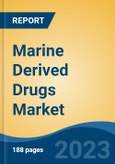Speak directly to the analyst to clarify any post sales queries you may have.
10% Free customizationThis report comes with 10% free customization, enabling you to add data that meets your specific business needs.
Advancements in marine biotechnology, particularly in marine genomics and bioinformatics, are accelerating the identification of novel pharmaceutical agents. These breakthroughs address critical industry challenges such as antimicrobial resistance and adverse effects linked to conventional synthetic drugs. Furthermore, the market is witnessing a strategic shift toward sustainable marine bioprospecting, with algae-derived compounds emerging as a dominant segment due to their scalability and alignment with global sustainability initiatives.
Key Market Drivers
Rich Biodiversity of Marine Ecosystems
The vast and diverse ecosystems of the world’s oceans serve as an untapped reservoir of bioactive compounds with immense pharmaceutical potential. The rich biodiversity of marine environments is a key driver behind the expansion of the global marine-derived drugs market, fueling novel drug discovery and commercialization.Marine ecosystems, spanning more than 70% of the Earth's surface, serve as a vast reservoir of biologically active compounds. These environments host a diverse array of microorganisms, invertebrates, and marine plants, many of which produce structurally unique secondary metabolites. These bioactive compounds are increasingly recognized for their potential in pharmaceutical innovation, offering novel therapeutic mechanisms that differentiate them from traditional synthetic drugs. These bioactive compounds, evolved over millions of years, exhibit structural complexity and pharmacological properties that are rarely found in terrestrial organisms.
Marine-derived molecules such as peptides, alkaloids, polyketides, and terpenoids have demonstrated anti-cancer, anti-inflammatory, antimicrobial, and neuroprotective activities. Unlike terrestrial organisms, marine species thrive in extreme conditions (deep-sea trenches, hydrothermal vents, Arctic waters), leading to the evolution of highly potent and stable bioactive compounds that can withstand diverse physiological environments in drug formulations. This unparalleled chemical diversity positions marine ecosystems as high-value resources for next-generation pharmaceuticals targeting diseases with limited treatment options.
Key Market Challenges
High Cost of Discovery and Development and
One of the most significant challenges in the marine-derived drugs market is the high cost associated with the discovery and development of new drugs. The process of identifying, isolating, and testing marine compounds is time-consuming and resource intensive. Researchers often require specialized equipment and access to remote marine environments, which adds to the overall expense.Key Market Trends
Advancements in Genomic and Metagenomic Technologies
Genomic and metagenomic technologies are revolutionizing marine drug discovery. By analyzing the DNA of marine organisms and their symbiotic microorganisms, researchers can identify potential drug candidates more efficiently. These techniques enable the discovery of previously hidden bioactive compounds and hold the promise of accelerating drug development.Key Market Players
- Abbott Laboratories Inc
- Bayer AG
- Takeda Pharmaceutical Co Ltd
- Marine Polymer Technologies Inc
- Sanofi SA
- Aphios Corp
- Aker BioMarine ASA
- AbbVie Inc
- GSK PLC
Report Scope:
In this report, the Global Marine Derived Drugs Market has been segmented into the following categories, in addition to the industry trends which have also been detailed below:Marine Derived Drugs Market, By Type:
- Ether
- Peptide
- Phenol
- Steroid
Marine Derived Drugs Market, By Source:
- Algae
- Invertebrates
- Microorganisms
Marine Derived Drugs Market, By Application:
- Anti-Cardiovascular
- Anti-Inflammatory
- Anti-Microbial
- Anti-Tumor
- Anti-Viral
Marine Derived Drugs Market, By Region:
- North America
- United States
- Canada
- Mexico
- Europe
- Germany
- United Kingdom
- France
- Italy
- Spain
- Asia-Pacific
- China
- Japan
- India
- Australia
- South Korea
- South America
- Brazil
- Argentina
- Colombia
- Middle East & Africa
- South Africa
- Saudi Arabia
- UAE
- Kuwait
Competitive Landscape
Company Profiles: Detailed analysis of the major companies present in the Global Marine Derived Drugs Market.Available Customizations:
With the given market data, the publisher offers customizations according to a company's specific needs. The following customization options are available for the report.Company Information
- Detailed analysis and profiling of additional market players (up to five).
This product will be delivered within 1-3 business days.
Table of Contents
Companies Mentioned
- Abbott Laboratories Inc
- Bayer AG
- Takeda Pharmaceutical Co Ltd
- Marine Polymer Technologies Inc
- Sanofi SA
- Aphios Corp
- Aker BioMarine ASA
- AbbVie Inc
- GSK PLC
Table Information
| Report Attribute | Details |
|---|---|
| No. of Pages | 185 |
| Published | March 2025 |
| Forecast Period | 2024 - 2030 |
| Estimated Market Value ( USD | $ 12.4 Billion |
| Forecasted Market Value ( USD | $ 20.96 Billion |
| Compound Annual Growth Rate | 9.1% |
| Regions Covered | Global |
| No. of Companies Mentioned | 9 |









